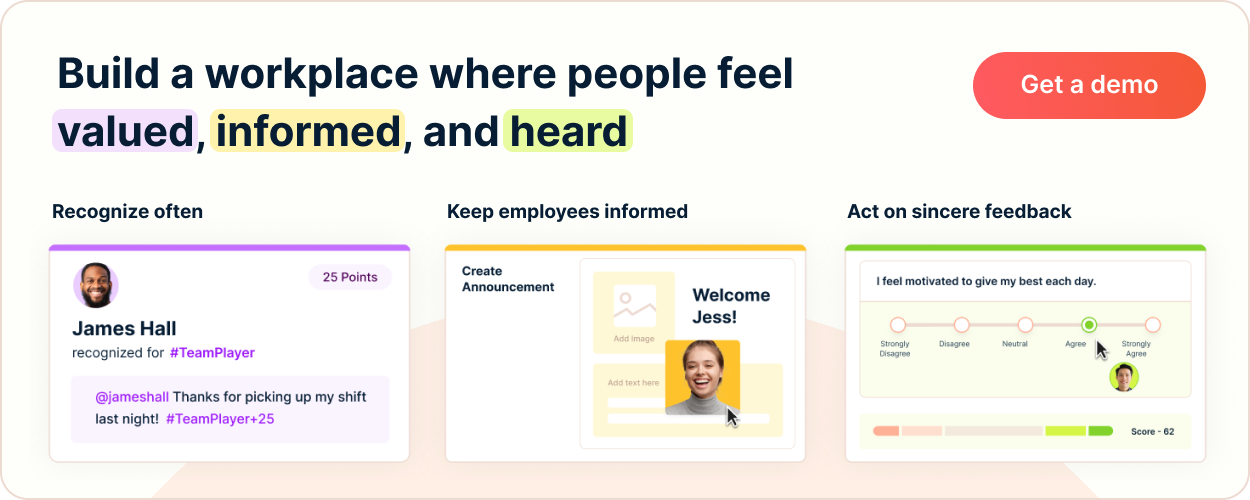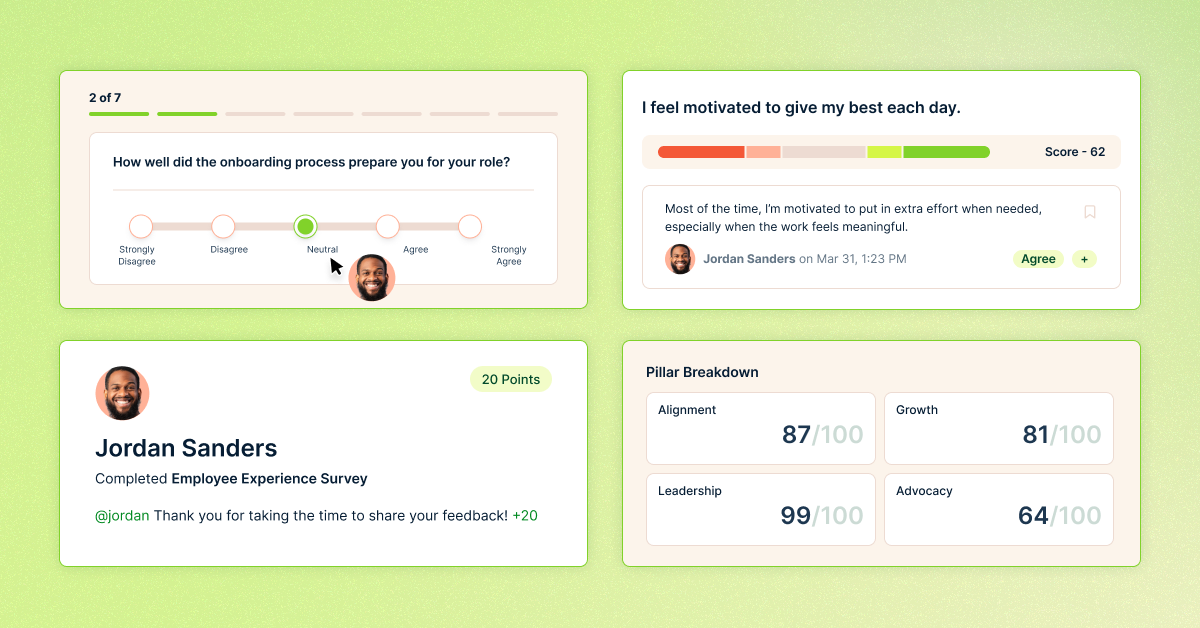Unlock The Power Of Company Culture By Building And Maintaining Organizational Values

Here's the TL;DR
Your company’s culture defines how people work, interact, and engage with your mission—but only if employees actually understand it. While a strong culture drives retention and performance, 43% of workers say they dislike their current company culture. The guide emphasizes that great culture doesn’t happen by accident—it takes intention, leadership, and strategy.
Core Elements That Shape Company Culture:
- Values: Core, aspirational, and accidental values set behavior expectations.
- Mission & Vision: Clarify purpose and direction.
- Leadership: Leaders model acceptable behaviors and influence morale.
- Communication: Transparent, compassionate messaging builds trust.
- Teamwork: Collaboration fosters inclusion and psychological safety.
- Recognition: Appreciation boosts motivation and retention.
- Work-Life Balance: Support for well-being drives focus and loyalty.
Steps to Build and Sustain Culture:
- Define core values through team input and examples, not buzzwords.
- Train leaders to model culture consistently and lead with intention.
- Communicate clearly using the six Cs: compassion, clarity, connection, etc.
- Pilot changes with engaged teams and scale slowly with feedback.
- Measure impact via KPIs like eNPS, turnover, and participation.
- Adapt for scale by embedding culture into onboarding and management training.
What does your company stand for? And more importantly, do your employees know? These questions are at the heart of your company culture — that hard-to-define vibe that shapes how your team works, communicates, and shows up every day.
When it’s good, it’s the kind of culture you want to bottle. In fact, 93.5% of employees told us they’d stay at a company for five years or more if the culture was great. But getting it right doesn’t happen by accident. It takes intention, consistency, and, often, a serious cultural transformation strategy, especially if you’re trying to shift outdated habits or rebuild trust.
But here’s the reality check: 43% of workers we surveyed don’t enjoy the culture at their current company.
This guide walks through everything you need to know about building a positive company culture, from defining your core values to actually living them across your organization.
What Is Company Culture?
Company culture is the general vibe you feel, see, and hear at work. It refers to the shared values and behaviors that exist in a work environment and explains “the way we do things around here.”
You can think of company culture as a spectrum. At the high end, you have organizations like Patagonia boasting a turnover rate of just 4% thanks to its enviable culture that others want to clone. At the other end, we’ve all heard tales of (or experienced) toxic work cultures shaped by internal conflict and horrendous leadership.
7 Key Elements Of Company Culture
So, what exactly makes up the unique recipe of a company’s culture? The following ingredients are all integral.
- Organizational values: Companies usually have a mix of core values (non-negotiable standards, carefully defined by leadership), aspirational values (those the company is working toward), and accidental values (usually developed organically due to situations beyond your control.)
- Vision and mission: These statements define your company’s purpose and long-term direction. A clear mission helps employees understand why their work matters, while a compelling vision rallies people around where the company is headed.
- Leadership: Leaders shape culture through their actions and their words. Whether hands-on or hands-off, intentional leaders model company values and encourage accountability.
- Communication: How you share information, formally and informally, impacts trust and team alignment. Great cultures prioritize communication that’s both clear and compassionate.
- Teamwork: Nothing weakens culture faster than siloed teams or disputes between peers. But a culture that values collaboration creates space for innovation, knowledge-sharing, and psychological safety.
- Recognition and appreciation: When employees are regularly recognized for their contributions, they feel seen and valued. Whether through shoutouts, awards, or simple thank-yous, appreciation fuels morale and motivation.
- Work-life balance: Healthy cultures acknowledge employees as whole humans who have lives beyond work. When people are supported in balancing their professional and personal lives, they show up more focused, loyal, and energized.
What Is The Impact Of Company Culture On Business Success?
A successful company culture directly supports employee engagement and retention. Louis Carter, founder of Most Loved Workplace® and author of In Great Company, puts it simply:
“When employees feel emotionally connected to the mission, aligned with values, and respected in their role, loyalty goes up significantly — and performance follows. It’s not about fear of losing a job. It’s about a genuine desire to stay and grow within a culture that honors them.”
Salesforce data echoes these performance gains with 70% of U.S. employees admitting that a connection to company culture prompts them to do their best work. When culture clicks, people show up with energy, commitment, and a sense of purpose.
How To Build A Strong Company Culture In 4 Steps
Companies at any maturity stage can benefit from a culture investment. Startups are well-placed to cement the foundations of a positive culture as they hire their first employees. But it’s never too late for established companies to pause and evaluate their current culture either. Here’s the process you should follow each time.
1. Establish Your Core Values
Start by identifying what already feels true about your company at its best and what you hope to achieve as you grow. This involves:
- Looking at your culture today: What do high-performing team members consistently do? What behaviors help you succeed?
- Talking to your team: Run surveys, host workshops, or hold one-on-one interviews to learn what people believe the company stands for and what they wish it stood for.
- Being selective: Choose three to five values that reflect your culture and support your goals. Avoid generic ones like “integrity” unless you can back them up with real examples and context.
Companies with the best cultures celebrate their values by publishing them online. For example, social media management company Buffer shares that its employees should:
- Default to transparency in everything they do
- Improve continuously to achieve both personal and professional growth
- Show gratitude for the many blessings that Buffer and its people bring to their lives
- Be no-ego doers and “row this boat together”
- Choose optimism even when involved in hard conversations
- Reflect to unblock, embracing vulnerability to focus on self-improvement
Nectar tip: Don’t be tempted to crib Buffer’s values. The best cultures are grounded in what your team actually believes and practices, not borrowed from what works well for another company.
2. Define Leadership’s Role In Culture Development
A positive workplace culture is shaped every day by the people at the top. Whether they realize it or not, leaders model what’s acceptable and how team members should respond in certain situations. This makes their role in building culture non-negotiable.
Example: When explorer Ernest Shackleton’s “Endurance” ship was destroyed by ice during an Antarctic expedition, survival became the only goal. Shackleton knew that mindset would make the difference, so he kept the most skeptical crew members close. From here, he could influence their outlook and stop negative thinking from spreading. His deliberate focus on improving morale and team culture brought all 28 men home safely.
The same principles apply at work where leaders set the emotional tone and shape team beliefs. When they show up with consistency and care, culture strengthens. But when they’re disconnected or unpredictable, trust erodes quickly.
That doesn’t mean every leader needs to be a cheerleader, but their actions should be intentional. Will they purposefully lead by example? Will they report back to HR with cultural feedback from the team? Will they reinforce values during hard decisions, or just when it’s convenient?
Austin Rulfs, Director at Zanda Wealth, finds the perfect balance between leadership and culture development by giving employees autonomy.
“I let my team experiment with processes, pitch better systems, and communicate with clients in ways that suit their rhythm. When someone has space to try, adjust, and own the result, they become more invested because their ideas move the needle. They stop waiting for permission to fix something that clearly isn’t working and they stop seeing management as an obstacle to improvement.”
3. Build Your Communication Strategies
Your employees won’t know you’re planning to revamp your company culture unless you spell it out for them. Shout loud and proud about any updates by incorporating culture communications information in your internal newsletters, team meetings, workshops, and company careers pages.
Using these communication vehicles will effectively spread the word, but carefully consider what you want your message to convey. Harvard Business School Professors Joshua Margolis and Anthony Mayo’s Organizational Leadership course includes the following advice on using the six Cs of communication:
- Compassion: Do you show your audience you care about their perspectives?
- Clarity: Do you communicate clearly to those unfamiliar with the message?
- Conciseness: Is the message short enough to internalize?
- Connection: Do you emotionally connect with your audience?
- Conviction: Do you demonstrate your commitment to the good of your organization?
- Courage: Do you demonstrate confidence in your ability to lead through uncertainty?
4. Develop Your Implementation Tactics
Rolling out an entirely new company culture strategy overnight is a huge risk. Culture change doesn’t happen all at once; it’s more likely to be effective if you start small, test what works, and give yourself space to adjust along the way.
Begin by piloting your culture initiatives in one team, department, or branch. Choose a group with engaged leadership and a solid communication structure who are well-positioned to give honest feedback and model change for the rest of the company.
Here are a few ways to start implementation on the right foot:
- Assign ownership: Decide who’s responsible for driving culture initiatives forward. This might be a dedicated People & Culture lead or a cross-functional team of internal champions.
- Create a rollout timeline: Set realistic deadlines for introducing your values, running leadership training, updating internal materials, and gathering feedback.
- Offer guidance and resources: Equip managers and team leads with talking points, toolkits, and FAQs so they’re confident in reinforcing the message.
- Share early wins: Highlight teams that are putting values into action and celebrate the small milestones.
How To Maintain And Evolve Your Corporate Culture
You’ve made a splash, introduced some cultural change, and even started to reap the rewards of your efforts. Next, you’ll want to make sure your culture campaign holds steady and doesn’t fizzle out once the novelty wears off. These HR best practices maintain the momentum.
Scale Culture According To Your Growth
As your company grows, your culture will naturally shift. What worked for a tight-knit team of 15 might not stick with a workforce of 150 or 1,500.
The goal here is to protect what matters most while making space for new voices and realities. Here’s what helps as you scale:
- Bake culture into onboarding: Make sure every new employee understands your values as the behaviors they should start modeling from day one.
- Train new managers well: Managers have a direct line to employee experience. Equip them with real tools to lead with empathy, reinforce values, and respond to feedback.
- Watch for cultural drift: As workplace siloes form and teams get busier, communication can start to break down. Keep an eye on alignment by checking in regularly and encouraging cross-team visibility.
Learn How To Manage Cultural Change
Even positive culture shifts can stir up resistance. People get used to doing things a certain way, and any type of unexplained change can feel highly disruptive.
A head-in-the-sand approach is your enemy here. You can get ahead of this sentiment by managing tension with transparency. Let your team know why the change is happening and always create space for them to ask questions without fear of repercussions.
Commit To Regular Culture Assessments
Your culture might seem on solid ground today, but what about next week when a respected manager quits, or in the aftermath of a change to your compensation strategy? Are you confident that employee engagement will remain high?
Gina Cotner, CEO of Athena Executive Services, explains why it’s important to take the pulse of your people:
“We survey our staff every six months asking for feedback about working here, asking about work/life balance, asking what they would like to see more of, etc. We are regularly interested in what is of interest or importance to them.”
This kind of regular check-in keeps you from making assumptions. Instead, you’ll catch issues early and stay aligned with what your team actually thinks and needs.
How To Measure Cultural Impact
Beyond a quick gut check to see if your culture “feels” any better since overhauling your organizational values, you can also follow a more scientific approach.
Set Key Performance Indicators (KPIs)
Choose KPIs that tie directly to your cultural goals and give you real insight into how your efforts are landing. These should reflect the emotional and operational health of your organization. Sample metrics might include:
- eNPS (Employee Net Promoter Score)
- Voluntary turnover rates
- Manager effectiveness scores
- Participation in recognition programs
- Internal promotion and mobility rates
- Absenteeism or burnout-related leave
- Feedback participation rates
Determine Your Return On Investment (ROI)
Every culture initiative comes with a cost attached, whether investing in leadership training, a new recognition platform, or just time spent rewriting your organizational values. But are those efforts paying off in real business terms?
To calculate ROI, compare the gains from your initiative against what you spent. For example, if you launched a recognition program and saw a drop in turnover, you can estimate how much that saved in rehiring and retraining costs.
Basic ROI formula:
ROI = (Net benefit from initiative – Cost of initiative) ÷ Cost of initiative × 100
Let’s say you spent $10,000 on a culture initiative and reduced turnover enough to save $30,000 in rehiring costs.
ROI = ($30,000 – $10,000) ÷ $10,000 × 100 = 200%
This strong return gives leadership a clear picture of the value behind the culture work. Where possible, tie results to real outcomes like lower attrition, improved productivity, or fewer employee relations issues. Even partial gains can add up over time.
Select Your Success Metrics
Keep an eye on the broader indicators of cultural health, too. These success metrics reflect how your culture holds up over time. Employee engagement and retention are two of the clearest signals.
- When engagement is high, people tend to be more focused, collaborative, and motivated. When it drops, it’s often a sign that something deeper in the culture needs attention.
- Retention tells you whether people feel connected to the company and its mission. A dip in retention may suggest misalignment, poor leadership and culture support, or values that aren’t being consistently upheld.
3 Common Culture Challenges (And How To Overcome Them)
Revamping your company culture is a powerful, inspiring project that should fill you and your people with hope. But among this positivity, it’s common to come up against some common roadblocks.
Nurturing Culture In Remote Teams
It’s one thing to keep tabs on what your culture looks like in the office, but quite another to oversee it in a remote or hybrid workplace environment. Without shared spaces or spontaneous hallway chats, teams risk feeling isolated or disconnected from company values.
Team building activities should be front and center of your remote work culture. Cassie Donegan is a Chief Operations Officer at Southern Sitters, a fully remote organization. To keep everyone connected, Cassie shares that she “regularly organizes virtual appreciation moments, team connection calls, and off-screen check-ins to maintain connection and cohesion, even across state lines.”
As a result, Southern Sitters has built a loyal admin team with minimal turnover and a strong sense of shared mission.
Aligning Your Culture With The Diversity Of Your Teams
Remote vs. in-office isn’t the only cultural consideration. As your workforce grows, so does the diversity of experiences, backgrounds, and values that shape how people interact with work. A one-size-fits-all culture approach often misses the mark.
Some companies still default to surface-level perks, like happy hours, ping pong tables, or loud office socials, as markers of a “fun” culture. But not everyone finds those environments comfortable or engaging. For many others, a strong culture is the expectation that you can ignore emails on the weekends or take Friday afternoons off during the summer months without guilt, as offered by Kelloggs.
Real cultural alignment is shaped by listening. Ask your team what makes them feel supported. Then design systems, rituals, and policies that reflect the range of experiences in your organization.
Facing Resistance To Change
Some employees will run a mile at the merest sniff of change to your culture. This resistance isn’t always loud; sometimes, it shows up as quiet disengagement or passive pushback from people unsure of what’s changing and why.
This is where leadership plays a pivotal role. If managers and execs aren’t bought in or don’t communicate consistently, it’s easy for teams to revert to old patterns.
To ease resistance, start by naming it. Acknowledge that change is uncomfortable. Then, connect the shift to your core values and the company’s long-term vision. Reinforce that the change is about evolving to meet new challenges and opportunities together.
Create A Culture Your Employees Will Never Want To Leave With Nectar
Building a positive company culture is a long-term commitment to making your workplace feel meaningful and supportive. Whether starting from scratch or refining a culture already in motion, Nectar is here to bring it to life.
Our employee recognition platform makes it easy to celebrate wins big and small, helping your people feel valued and motivated every day. You can also use our built-in internal communication tools to reinforce company values, share updates, and keep everyone connected, no matter where they work.
Ready to turn your culture vision into action? Schedule a free Nectar demo and subscribe to our newsletter for the latest culture updates.















